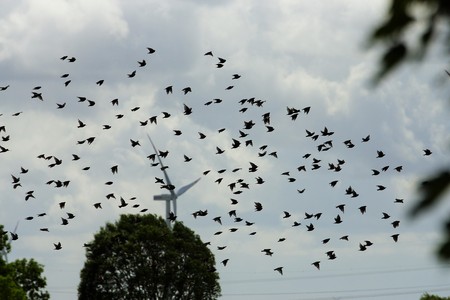President Joe Biden and a number of other global leaders have espoused the new COVID-19 recovery mantra: “Build Back Better.” Biden’s Build Back Better page for example outlines the importance of addressing environmental injustice.
If their aim is to create a better world and a better environment, I propose a solution to build back a better environment for the wildlife in the United States, especially for the avian species like the Golden Eagle.
A wind turbine-free environment will help the recovery of raptors, migratory species, and other species of ecological importance that have been brutally slaughtered by wind turbines during the course of the past three decades.
A Wind Energy-Free environment should be a central part of any “build back better” program. Here’s why.
Bird Conservation during the 1970s Environmental Movement: Courtesy Silent Spring.
Silent Spring, a book by Rachel Carson, propelled the environmental movements during the 1960s and 70s. Bird conservation has been at the heart of the modern environmental movement since the release of this book.
The book called for a ban on DDT–dichlorodiphenyltrichloroethane, a commonly used pesticide–and was instrumental in influencing a ban on DDT which came into effect in 1972.
Scientific American notes that her book was instrumental in helping bird populations recover, especially raptors like peregrine falcon and bald eagle: “Without the 1972 ban on DDT and ensuing protections, the bald eagle, let alone dozens of other bird species, would likely be gone now in the continental U.S. And without the song of the birds, the spring would be a very silent time indeed.”
No Longer Silent: Noisy Wind Turbines Slice Birds into Oblivion
Birds now face a threat that is much bigger than DDT or any of the threats they’ve encountered since the Industrial revolution: Wind Turbines. Wind Turbine impact on birds and their systemic role in the reduction of bird population is documented across the globe, including the United States.
Wind turbines kill an estimated 573,000 birds annually in the United States alone. Experts indicate that this number could go to 1.4 million (annual kills) by 2030 if Wind turbines are continued to be installed and operated.
Mainstream media journalists and renewable-industry evangelists tend to dismiss bird mortality from Wind Turbines as “insignificant” when compared to other causes of bird mortality and sometimes even call it a necessity to reduce fossil fuel emissions.
However, scientists, avian conservationists and people who have done unbiased research on ths matter have not taken wind-turbine mortality lightly, and Wind Turbines are continued to be viewed as a significant hurdle in helping bird populations recover from plummeting numbers. Some journalists like Avery Thompson (from Popular Mechanics) understand this and say that “Turbines Kill So Many Birds They’re Effectively an Apex Predator.”
Species killed at turbines are often taxonomically related, as have similar flight characteristics and tend to display similar risks of getting slaughtered by Wind turbines. Raptors like Eagles, Harriers, Falcons are a group of species that are at high risk of Wind Turbine collision. Tethys, an entity that studies the environmental effects of wind and marine renewable energy technologies, explains that “Raptors are at high risk for collision with wind turbine blades because they have wind-specific flight behaviors and typically soar during high winds, bringing them to the same elevation as wind turbine blades.”
Birds of Prey such as the long-eared owl, ferruginous hawk, Swainson’s hawk, and the golden eagle, were found to be at high risk of population decline from Wind Turbine mortality. A recent study that was aimed at helping conservationists prioritize their target species for conservation confirms this bias in impact mortality towards Raptors. High‐resolution GPS tracking (for collision risk assessments) have shown that raptor fatality from wind turbines is a growing problem and more recent Studies have shown that Wind turbine fatalities approach “a level of concern in raptor populations” globally.
In light of this undeniable evidence for the risk posed to raptor populations, it would be wise for Biden and other leaders to drop their Wind energy expansion plans. If their motive is to protect the environment and the ecological systems, then they would do their best to halt the commissioning of Wind turbines. Instead, the issue of bird mortality from wind turbine collision remains absent from the environmental policies across the globe.
Further, the argument provided for the benefits of Wind energy are extremely weak. Wind energy remains a highly unreliable and expensive energy source despite decades of research and development. Reliance on Wind Energy, along with Solar, are known to increase electricity prices, disrupt the grid functionality and cause major blackouts.
Besides, wind farms do not function during less-optimal wind flow and thus require backup from fossil fuel or nuclear sources. Also, contrary to popular perception, wind turbines are not non-fossil fuel based. Fossil fuels are required to manufacture the Wind tower, the blades and the turbines. In essence, there is no Wind energy without fossil fuels. So, the notion that Wind energy is a morally superior form of energy is absolutely false.
The unproven future benefits of Wind energy and lies about its present benefits are not a strong enough reason to let the murder of birds go unabated. Biden, and any environmentally rational minded person, should call for ban in the commissioning of new wind farms and reduce the operation of existing wind farms.
Vijay Jayaraj (M.Sc., Environmental Science, University of East Anglia, England), is a Research Contributor for the Cornwall Alliance for the Stewardship of Creation and resides in India.
